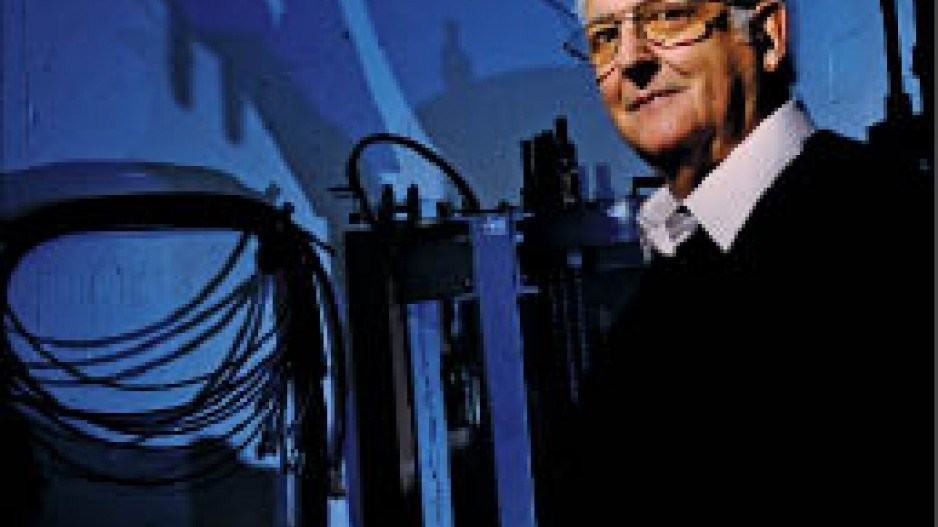Seismic activity
Ever wondered what would happen if an earthquake rocked the Lower Mainland while you were about to drive through the George Massey Tunnel?
Fortunately, Iain Weir-Jonesand his engineers have asked that question and come up with an early warning system designed to shut the tunnel down to traffic moments before an earthquake hits.
The Weir-Jones Group?s seismic early warning system (SEWS) is just one of the devices the company has developed over the years. It?s a small part of what the company does, but Weir-Jones believes there?s a big market for SEWS.
?I see that becoming a major part of our business,? the 68-year-old engineer said during a recent interview.
Founded in 1971, the company has two main divisions. Terrasciences Systems Ltd. – owned by Weir-Jones? wife, Elizabeth – develops a wide range of sensors and electronics for the oil and gas, marine and mining sectors.
Weir-Jones (a.k.a. ?Doc Roc? – the name on his licence plate) is president of the Weir-Jones engineering group. Headquartered in Vancouver, the company?s two divisions employ 32 engineers and software specialists.
The company is diversified and highly specialized. Primarily it makes devices that detect and analyze motion and seismic activity – from reading pressure variations in the hulls of BC Ferries vessels to systems that allow oil and gas companies to monitor the volume and movement of oil in Alberta?s tarsands.
About seven years ago, Capt. Bill Hughes, navigational equipment and systems project lead for Washington State Ferries, went shopping for a company to provide specialized navigational equipment for the state?s fleet of 22 vessels. He contacted BC Ferries, which recommended Weir-Jones.
The company outfitted the American ferry fleet with its ADIS (automated draft indicator system).
Over the years, the ferry company asked for an alarm system and other additional functions to be built into the devices. Hughes said Weir-Jones? engineers are always able to provide tailor-made solutions.
?He is just extremely helpful, creative in solutions, innovative and always delivers whenever asked,? Hughes said of Weir-Jones. ?There?s no challenge that they haven?t been able to meet, and we?ve come up with some unique ones for them.?
Born and raised in England, Weir-Jones left – fled, actually – in 1968. Asked why he left, Weir-Jones answered with one word: ?socialism.?
In the late 1960s, high tax rates and high unemployment drove him and many of his fellow grads out of the U.K. After earning a degree in engineering, he came to Canada in his early 20s and worked as a hard-rock miner to earn enough money to go back to school in England to earn a PhD in geo-mechanics.
?It?s one of the reasons I?m deaf,? he explained (he wears a hearing aid). ?I ran a rock drill.?
After Weir-Jones earned his PhD, he and his wife – a linguist who speaks several languages – immigrated to Canada. He worked briefly with Inco in Ontario, before being headhunted by the University of British Columbia (UBC) in 1970.
He taught geomechanics at UBC until 1977, when he left to devote his full attention to the engineering company he had been running off the side of his desk.
He and his engineers worked initially with power utilities like BC Hydro and then branched out into the oil and gas industry. The company found its niche in seismic detection and analysis.
?The work that?s being done in his office, a great deal of it has been ground-breaking,? said his wife, Elizabeth Weir-Jones.
?For a small company such as his – up against some very large companies – he?s achieved work that other companies would really have liked. He?s managed to do it through his own persistence and his own expertise.?
Although she owns Terrasciences Systems and provides her husband strategic planning advice, Elizabeth Weir-Jones does not take an active role in the company?s day-to-day business.
Iain Weir-Jones? company is involved in a range of sectors, including railways, civil engineering, mining, pipelines and oil and gas.
?We don?t do routine engineering,? Weir-Jones said. ?The projects we work on are, for the most part, unique. In some respects, we?ve become even more specialized.?
A tour of the company?s Vancouver office underscores the point. In one area, an engineer tests computerized components for another company to see how they function at cold temperatures.
In another corner, engineers work on a device that picks up seismic vibrations to alert the Canadian Pacific Railway when a rockslide is significant enough to pose a hazard to its trains.
Weir-Jones also developed the AutoTRAQ missile tracking system for the Canadian military.
He pointed out that earthquake-prone West Coast is an ideal place to implement SEWS.
Earthquakes send out a series of shock waves. The first, a P-wave, precedes the more damaging S-wave. SEWS can analyze the P-wave, determine if it?s a significant event and automatically shut down tunnels, bridges, oil and gas lines and elevators in highrises.
Weir-Jones said the damage in Fukushima, Japan, earlier this year might not have been as severe had some of the utilities and infrastructure there had early warning systems.
?Had they had one of our systems, they would have been able to take some precautions,? he said.
He sees SEWS becoming a key product for his company, which is slowly growing.
?Our revenues are up,? he said. ?I?m looking to hire more specialized staff.?
Attracting and keeping skilled engineers is always a challenge. Weir-Jones has drawn his workforce from all over the world, and his retention strategy is based on the golden rule.
?I try to treat my employees in the way that I?d like to be treated,? Weir-Jones said. ?I want people to be happy working here.? ?




